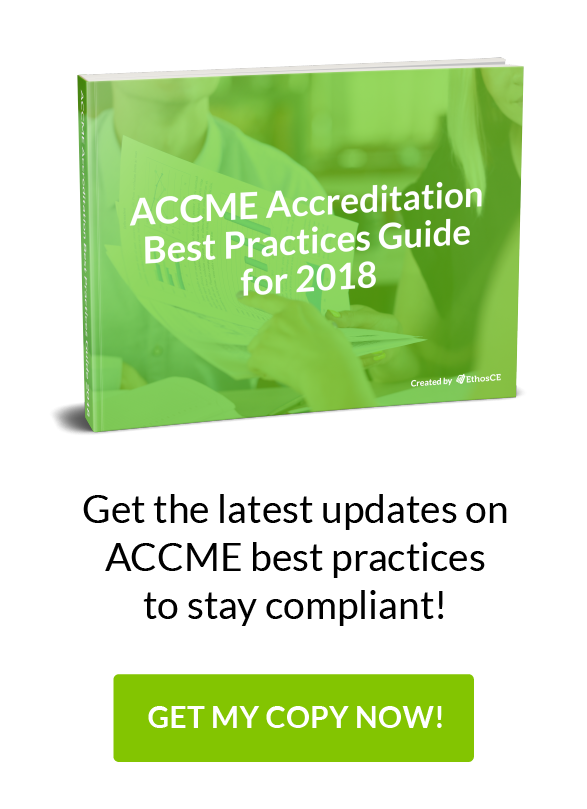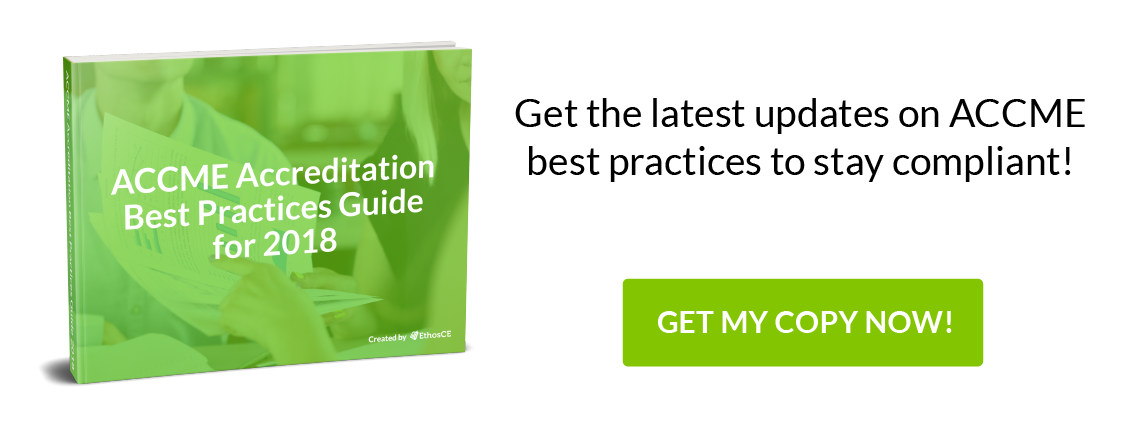Creating a Joint Sponsorship Agreement for CME Credit
Once you’ve decided to pursue a joint providership agreement for credit with another provider, you’ll have several important steps to take in order to be ready to submit your application.
First, we’ll review the latest requirements for assigning AMA PRA Category 1 Credit™ for CME activities, then we’ll look at best practices in creating an agreement.
1. CME providers are required to:
a. Develop and offer activities that comply with AMA PRA core and format-specific requirements for each approved learning format approved by the AMA.
b. Be recognized as an accredited CME provider by the ACCME or an ACCME-recognized state medical society (SMS). Organizations not holding accreditation must hold a joint providership agreement with an accredited provider.
2. The types of CME content eligible for credit must:
A. Align with the AMA’s definition of CME:
Educational activities which serve to develop, support, or enhance the knowledge and competencies that form the foundation of excellence in professional performance, as well as the relationships crucial to high-quality healthcare delivery.
The content of CME is the “body of knowledge and skills generally recognized and accepted by the profession as within the basic medical sciences, the discipline of clinical medicine and the provision of health care to the public.” (AMA HOD policy #300.988).
B. Be non-promotional
Be non-promotional and appropriate in range and scope for its targeted physician audience. Accredited CME providers are allowed to certify nonclinical subjects (such as patient-physician communications, or office management) for AMA PRA Category 1 Credit™ providing these activities “benefit the profession, patient care or public health.”
C. Use of alternative medical practices
When CME activities explore the use of alternative medical practices, they must be presented along with scientific evidence that supports their use. CME activity needs to include discussion of the existing level of scientific evidence regarding their validity as a medical practice. CME content which advocates the use of alternative therapies without supporting scientific evidence will not be certified.
Further details on how AMA PRA Category 1 Credit™ credits are assigned per activity are available here.
After you’ve established that your content is eligible for AMA PRA Category 1 Credit™, you’ll need to create an agreement.
Let’s take a look at a sample document
This agreement is between (accredited partner’s name here), hereafter referred to as The Provider, and the <<Name of specialty society>> a non-accredited sponsor of continuing medical education (hereafter referred to as Non-Accredited Provider). This agreement covers the <<Name of Activity>>, <<Date(s)>>, <<Location>>.
By its authorized signature on this agreement, the Non-Accredited Provider affirms that this CME activity will serve to develop, maintain, or increase the knowledge, skills and professional performance that a physician uses to provide services for patients, the public or the profession. Further, the Non-Accredited Provider accepts accountability for all aspects in the planning and implementation of these CME activities in compliance with the Accreditation Criteria, Policies and Standards for Commercial Support of the Accreditation Council for Continuing Medical Education (ACCME).
The Provider and Non-Accredited Provider agree to the following:
All proposed CME activities must be reviewed and approved by The Provider to ensure compliance with the Accreditation Criteria, Policies and Standards for Commercial Support of the ACCME.
The Provider, as the ACCME-accredited sponsor, will assign the appropriate AMA PRA Category 1 Credits™ for the joint activity. Further, The Provider shall have the authority to withdraw the designation of credit and revoke this Agreement at any time during the planning or implementation of the activity if the Non-Accredited Provider fails to meet the requirements of The Provider or the terms of this Agreement. All required documentation listed on the joint providership CME Activity Planning Form must be received in a timely fashion.
All CME Letters of Agreement (LOAs) regarding grants and commercial support shall be between The Provider and the commercial supporter and will be initiated by The Provider. The Non-Accredited Provider is required to notify The Provider within 15 days of receiving confirmation of grant support with pertinent contact information. In accordance with ACCME policies, grant requests or Letters of Agreement cannot include an offer of or request for free exhibit space. This ensures a separation of education and promotion. Letters of Agreement must be between The Provider and the commercial supporter and be signed by both parties before the CME activity begins.
All promotional materials (brochures, advertisements, preliminary and final programs) must be reviewed and approved by (CE name), Manager, The Provider CME Administration prior to being printed. This will ensure that required information is communicated to the participants of the accredited CME activity.
Accreditation of the proposed CME activity cannot be advertised prior to The Provider approval.
For the Non-Accredited Provider not managed by The Provider Society Relations Department, a joint providership fee of $XXXX will be invoiced by The Provider.
Non-Accredited Provider agrees to indemnify and hold harmless The Provider against any claims or expenses arising from Non-Accredited Provider’s CME activities.
It’s a highly complicated document, to say the least, and each component has specific relevance to important areas of ACCME compliance.
Here are some tips to help you evaluate your joint providership agreement and maintain compliance with AMA and ACCME standards:
- Make certain that your agreement uses language that clearly states your intent to comply with ACCME regulations, as well as shows the intent to provide required documentation for all activities.
- Develop a deep understanding of how AMA PRA Category 1 Credit™ is assessed and assigned and maintain comprehensive documentation of your program’s compliance with credit evaluation standards.
- Be certain that the methods that each provider uses to evaluate compliance status and learner outcomes are equal in rigor.
Examine AMA and ACCME standards alignment further here.
Next Steps
A joint providership agreement isn’t a document that you’ll want to attempt without a thorough review of the regulations, standards, and legal implications of your partnership.
Don’t attempt this alone. Ethos CE has more than 16 years of experience in helping medical associations to maintain compliance and expand their CME programming. Our services will manage your joint providership agreements, documentation, and submission to the ACCME.
You can click here now to request a time to speak 1-on-1 with our CME technology experts to explore new ways you can simplify your ACCME accreditation submission process!
 We're now part of the Cadmium product suite! Learn more
We're now part of the Cadmium product suite! Learn more 


